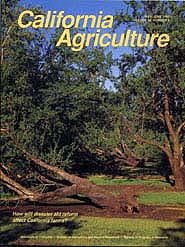All Issues

How will disaster aid reform affect California farms?
Cover:
Toppled almond trees were a common sight in the Central Valley after March storms wreaked their havoc. Almonds were just one of many commodities damaged by the wind, rain and cold.
Almond trees had more leaves out in March than other trees. The leaf canopy acted like a sail, catching the 40 to 60 mile an hour winds and rocking the trees in saturated soils until their shallow roots pulled loose. Photo by Jack Kelly Clark
May-June 1995
Volume 49, Number 3
Volume 49, Number 3





